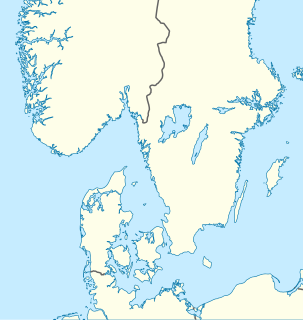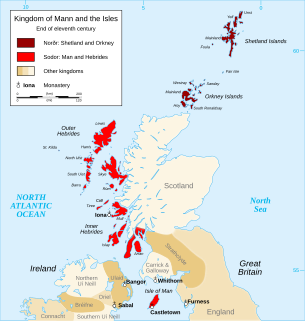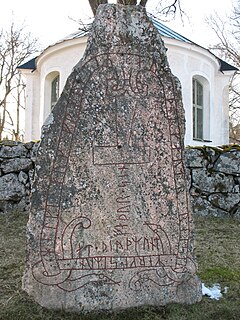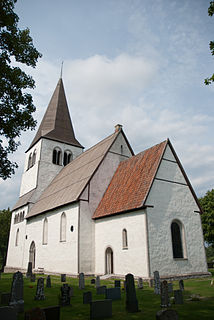
Runestone G 319 is the Rundata catalog number for a runic inscription on a runestone made from limestone that is located in the Rute church in Gotland, Sweden.

Runestone G 319 is the Rundata catalog number for a runic inscription on a runestone made from limestone that is located in the Rute church in Gotland, Sweden.
The runestone, which is 1.76 meters tall and 0.765 meters wide, is dated to the years 1200 – 1250. [1] Similar to many runestones, it was repurposed and used in the construction of a church. It was first described as being in the Rute church in a runestone survey published 1749. [2] The stone was hidden under a wooden floor in the 1870s, and removed to its current location during a church restoration in 1951. [2] It is the only Gotland runestone that mentions Finland. The word "Aglia" at the end of the inscription is problematic, but it has been interpreted as focusing the place of death of Audvalds. [2]
This runestone is considered to be one of the Baltic area runestones, which are Varangian runestones raised in memory of men who took part in peaceful or warlike expeditions across the Baltic Sea, where Finland and the Baltic states are presently located.
Original inscription:
si[h]tris : aruar[r] : litu : giera : st[a]en : yfir : auþu-l- : broþur : sin : a : finlandi : do : aglia... [3]
Translation to Old West Norse:
Sigtryggs(?) arfar létu gera stein yfir Auðv[a]l[d](?), bróður sinn, á Finnlandi dó 〈aglia...〉.
Translation to English:
Sigtryggr's(?) heirs had the stone made over Auðvaldr(?), their brother, who died in Finland ...

The Ardre image stones are a collection of ten rune and image stones, dated to the 8th to 11th centuries, that were discovered at Ardre Church, in Ardre, Gotland, Sweden. The principal edition is by Sune Lindqvist.

The Saleby Runestone, designated as Vg 67 in the Rundata catalog, was originally located in Saleby, Västra Götaland County, Sweden, which is in the historic province of Västergötland, and is one of the few runestones that is raised in memory of a woman.

The Ingvar Runestones is the name of around 26 Varangian Runestones that were raised in commemoration of those who died in the Swedish Viking expedition to the Caspian Sea of Ingvar the Far-Travelled.

The Greece runestones are about 30 runestones containing information related to voyages made by Norsemen to the Byzantine Empire. They were made during the Viking Age until about 1100 and were engraved in the Old Norse language with Scandinavian runes. All the stones have been found in modern-day Sweden, the majority in Uppland and Södermanland. Most were inscribed in memory of members of the Varangian Guard who never returned home, but a few inscriptions mention men who returned with wealth, and a boulder in Ed was engraved on the orders of a former officer of the Guard.

The Italy runestones are three or four Varangian runestones from 11th-century Sweden that tell of warriors who died in Langbarðaland, the Old Norse name for Italy. On these rune stones it is southern Italy that is referred to (Langobardia), but the Rundata project renders it rather anachronistically as Lombardy.

The England runestones are a group of about 30 runestones in Northern Europe which refer to Viking Age voyages to England. They constitute one of the largest groups of runestones that mention voyages to other countries, and they are comparable in number only to the approximately 30 Greece Runestones and the 26 Ingvar Runestones, of which the latter refer to a Viking expedition near the Caspian Sea. They were engraved in Old Norse with the Younger Futhark.

The Varangian Runestones are runestones in Scandinavia that mention voyages to the East or the Eastern route, or to more specific eastern locations such as Garðaríki.

The Sigurd stones form a group of eight or nine Swedish runic inscriptions and one picture stone that depict imagery from the Germanic heroic legend of Sigurd the dragon slayer. They were made during the Viking Age and constitute the earliest Norse representations of the matter of the Völsung cycle that is the basis of the Middle High German Nibelungenlied and the Sigurd legends in the Poetic Edda, the Prose Edda, and the Völsunga saga.

The Viking runestones are runestones that mention Scandinavians who participated in Viking expeditions. This article treats the runestone that refer to people who took part in voyages abroad, in western Europe, and stones that mention men who were Viking warriors and/or died while travelling in the West. However, it is likely that all of them do not mention men who took part in pillaging. The inscriptions were all engraved in Old Norse with the Younger Futhark. The runestones are unevenly distributed in Scandinavia: Denmark has 250 runestones, Norway has 50 while Iceland has none. Sweden have as many as between 1,700 and 2,500 depending on definition. The Swedish district of Uppland has the highest concentration with as many as 1,196 inscriptions in stone, whereas Södermanland is second with 391.

The Baltic area runestones are Varangian runestones in memory of men who took part in peaceful or warlike expeditions across the Baltic Sea, where Finland and the Baltic states are presently located.

The Runestones at Aspa are a set of four runestones located at Aspa, about six kilometers north of Runtuna, Södermanland, Sweden, where a road has passed a creek since prehistoric times. One of the stones, Sö Fv1948;289, is the oldest surviving native Scandinavian source that mentions the Kingdom of Sweden beside the runestones DR 344 and DR 216. Another stone, Sö 137, was apparently raised in memory of a Viking who had spent time in the west.

The Berezan' Runestone was discovered in 1905 by Ernst von Stern, professor at Odessa, on Berezan' Island where the Dnieper River meets the Black Sea. The runestone is 48 cm (19 in) wide, 47 cm (19 in) high and 12 cm (4.7 in) thick, and kept in the museum of Odessa. It was made by a Varangian (Viking) trader named Grani in memory of his business partner Karl. They were probably from Gotland, Sweden.

The Manx runestones were made by the Norse population on the Isle of Man during the Viking Age, mostly in the 10th century. Despite its small size, the Isle of Man stands out with many Viking Age runestones, in 1983 numbering as many as 26 surviving stones, which can be compared to 33 in all of Norway. So many of them may appear on the Isle of Man because of the merging of the immigrant Norse runestone tradition with the local Celtic tradition of raising high crosses.

The Torsätra runestone, cataloged by Rundata as runic inscription U 614, is a Viking Age memorial runestone originally located in Torsätra, which is around 8 kilometers northeast of Bro, Stockholm County, Sweden, which is in the historic province of Uppland.

The Stenkvista runestone, designated as runic inscription Sö 111 in the Rundata catalog, is a memorial runestone located near the church at Stenkvista, which is two kilometers east of Skogstorp, Södermanland County, Sweden, which was formerly part of the historic Södermanland, and which features a depiction of Thor's hammer, Mjöllnir. This runestone is one of several runestones in Scandinavia that has a dedication to Thor. While the tradition of carving inscriptions into boulders began in the 4th century and lasted into the 12th century, most runestones in Scandinavia date from the late Viking Age.

The Sønder Kirkeby Runestone, listed as runic inscription DR 220 in the Rundata catalog, is a Viking Age memorial runestone that was discovered in Sønder Kirkeby, which is located about 5 kilometers east of Nykøbing Falster, Denmark.

The Vidbo Runestones are two Viking Age memorial runestones that are located in the churchyard of the Vidbo church, which is about 10 km (6.2 mi) east of Knivsta, Uppsala County, Sweden, in the historic province of Uppland.

Rute Church is a medieval church in Rute on the Swedish island Gotland, in the Baltic Sea. The 13th century church contains medieval murals, and is unusual in that its vaults are supported by square pillars and not round columns. It belongs to the Diocese of Visby.

Gästrikland Runic Inscription 13 or Gs 13 is a runestone carved on red sandstone located in a church in Gävle, Gästrikland. It was carved in the 11th century by the runemaster Åsmund Kåresson.

Runestone U 582 is a runestone formerly located by the church of Söderby-Karl, Norrtälje municipality, in the Roslagen area on the east coast of Sweden. It has been lost since some time before 1830. The runestone has been dated to the 11th century and includes what is probably the earliest known written mention of Finland.
| Wikimedia Commons has media related to Gotlands runinskrifter 319 . |